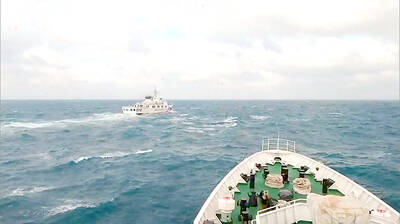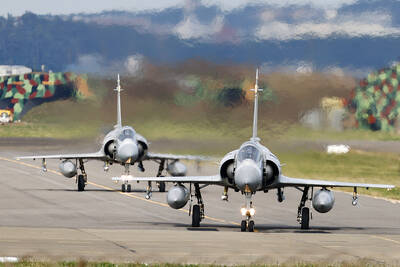North Korea has recently created an army division in charge of newly developed intermediate-range missiles capable of striking US forces in Japan and Guam, a South Korean news agency said yesterday.
The report came as North Korea stepped up its war rhetoric against the US and South Korea after the allies started annual drills aimed at improving their defense capabilities.
The North’s People’s Army recently launched a division supervising operational deployment of missiles with a range of more than 3,000km that it had developed in recent years, Yonhap news agency reported citing an unidentified South Korean government source.
The missiles could pose a threat to US forces in Japan, Guam and other Pacific areas that are to be redeployed in time of emergency on the Korean Peninsula, Yonhap said. The report, however, didn’t provide further details such as how many missiles the new division possesses and where they are positioned.
South Korea’s Defense Ministry said yesterday it couldn’t confirm the Yonhap report. However, a ministry document published last year showed that the North deployed a new type of medium-range missile believed to be the one it displayed during a military parade in 2007.
If confirmed, the division’s launch could suggest that the North has succeeded in developing more medium-range missiles since 2007 and it needed a bigger unit to manage them, said Ohm Tae-am of the state-run Korea Institute for Defense Analyses in Seoul.
The division’s creation would also mean the North has a unit whose primary role is to prevent the US from redeploying its troops in the Pacific to the Korean Peninsula in the event of a conflict, said Baek Seung-joo of the same institute.
North Korea’s missile program and nuclear weapons development program are major regional security concerns.
The North conducted a long-range rocket test in April in violation of a UN Security Council resolution that prohibits the country from engaging in any ballistic missile-related activities.
Yesterday, the North continued its salvo against the US and South Korea over their military drills. About 18,000 US soldiers and an undisclosed number of South Korean troops are taking part in 11 days of drills that began on Monday.
“This cannot be interpreted otherwise than a grave provocation,” the North’s Foreign Ministry said in a statement.
It said the North will continue to bolster its nuclear capability as long as the US military threats persist.
The ministry, however, said the North is ready for both dialogue and war, a position that contrasts with a military statement on Sunday that the North would break off dialogue with the US in response to the drills.

The Ministry of Foreign Affairs (MOFA) yesterday said it is closely monitoring developments in Venezuela, and would continue to cooperate with democratic allies and work together for regional and global security, stability, and prosperity. The remarks came after the US on Saturday launched a series of airstrikes in Venezuela and kidnapped Venezuelan President Nicolas Maduro, who was later flown to New York along with his wife. The pair face US charges related to drug trafficking and alleged cooperation with gangs designated as terrorist organizations. Maduro has denied the allegations. The ministry said that it is closely monitoring the political and economic situation

UNRELENTING: China attempted cyberattacks on Taiwan’s critical infrastructure 2.63 million times per day last year, up from 1.23 million in 2023, the NSB said China’s cyberarmy has long engaged in cyberattacks against Taiwan’s critical infrastructure, employing diverse and evolving tactics, the National Security Bureau (NSB) said yesterday, adding that cyberattacks on critical energy infrastructure last year increased 10-fold compared with the previous year. The NSB yesterday released a report titled Analysis on China’s Cyber Threats to Taiwan’s Critical Infrastructure in 2025, outlining the number of cyberattacks, major tactics and hacker groups. Taiwan’s national intelligence community identified a large number of cybersecurity incidents last year, the bureau said in a statement. China’s cyberarmy last year launched an average of 2.63 million intrusion attempts per day targeting Taiwan’s critical

‘SLICING METHOD’: In the event of a blockade, the China Coast Guard would intercept Taiwanese ships while its navy would seek to deter foreign intervention China’s military drills around Taiwan this week signaled potential strategies to cut the nation off from energy supplies and foreign military assistance, a US think tank report said. The Chinese People’s Liberation Army (PLA) conducted what it called “Justice Mission 2025” exercises from Monday to Tuesday in five maritime zones and airspace around Taiwan, calling them a warning to “Taiwanese independence” forces. In a report released on Wednesday, the Institute for the Study of War said the exercises effectively simulated blocking shipping routes to major port cities, including Kaohsiung, Keelung and Hualien. Taiwan would be highly vulnerable under such a blockade, because it

UNDER WAY: The contract for advanced sensor systems would be fulfilled in Florida, and is expected to be completed by June 2031, the Pentagon said Lockheed Martin has been given a contract involving foreign military sales to Taiwan to meet what Washington calls “an urgent operational need” of Taiwan’s air force, the Pentagon said on Wednesday. The contract has a ceiling value of US$328.5 million, with US$157.3 million in foreign military sales funds obligated at the time of award, the Pentagon said in a statement. “This contract provides for the procurement and delivery of 55 Infrared Search and Track Legion Enhanced Sensor Pods, processors, pod containers and processor containers required to meet the urgent operational need of the Taiwan air force,” it said. The contract’s work would be